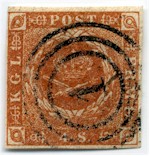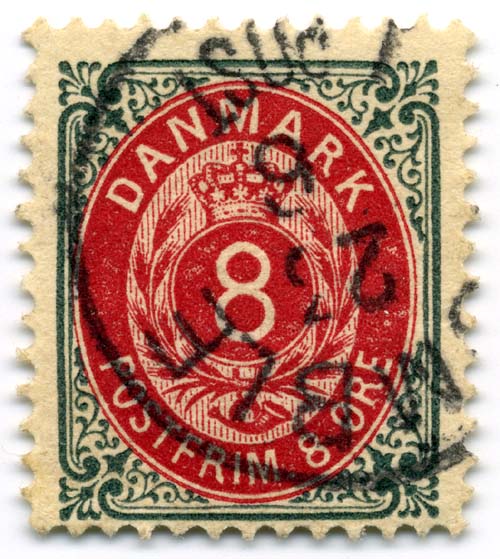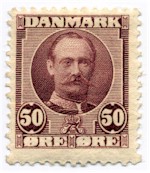 |
| Source |
 |
| Source |
This was followed on 1 May by a 2rbs value in blue using the denomination as the design.
Both stamps were typographed, watermarked (with a crown), and imperforate, and distinctive for having a yellow-brown burelage printed on top of the design. The 2rbs prepaid the local postage rate in Kobenhavn, while the 4rbs was the national rate.
The design and first printings were made by M. W. Ferslew, but he died and the subsequent printing was by H. H. Thiele, whose firm printed Denmark's stamps for the next 80 years.
Four rbs stamps were introduced on 1st May 1851 for use in the Duchy of Slesvig.
 |
| Source |
Along with postage stamps, the use of numeral cancellations was adopted, consisting of a number with several concentric circles, each number corresponding to a particular post office. "1" was Copenhagen, "2" the office in Hamburg, "5" Aarhus, and so forth.
The Second War of Schleswig in 1864 was a traumatic loss for Denmark, and immediately after it a new issue of stamps featured the traditional symbols of royalty more prominently than the previous issues. Values of 2s, 3s, 4s, 8s, and 16s came out between May 1864 and 1868. These were the first Danish stamps to be perforated.
 |
| Source |
In 1873, the currency was changed to the decimal kroner, which necessitated new stamps. The perforation spacing was changed in 1895, and the watermark in 1902.
Meanwhile, in 1882 the Universal Postal Union standardised on particular colours of stamps for international mail. The "Arms type" was designed to meet this requirement; the 5 ore printed in green, and the 20 ore in blue, followed up in 1885 by a 10 ore in red.
 |
| Source: GPFS |
In 1904, King Christian IX became the first king of Denmark to be depicted on a stamp.
 |
| Source: GPFS |
In the following year, a new type of numeral design appeared for the lower values - denomination in an oval with three wavy lines on each side, representing the three waters separating the largest Danish islands. This design proved so popular that variations on it remain in use as of 2003.
 |
| Source |
In 1912, several types of stamps were surcharged to 35 ore. In the same year, Denmark's first pictorial stamp was a 5-kroner issue depicting the Copenhagen General Post Office.
King Christian X appeared in profile between 1913 and 1928, in a long-lived series that featured a number of colour and value changes.
In 1918, a need for 27 ore value resulted in surcharges on newspaper stamps.
On 5 October 1920, Denmark's first commemorative stamps, a set of three pictorials, marked the reunion of northern Schleswig with Denmark following a plebiscite. 1924 saw commemoratives for the 300th anniversary of the postal service, and in 1926 the original two designs were adapted for an issue noting the 75th anniversary of their introduction.
In 1927 a set of six stamps depicted a caravel, modelled after an old engraving. The 1927 set was typographed; from 1933 to 1940 the design was reissued with the use of engraving instead. The engraved design was soon changed to reduce the left-side margin, with the "Type IIs" having only one column of squares between sail and frame line, where the "Type Is" have two columns.
The GPFS website (on which the above description is based) has detailed information on these issues:
Also see the detailed Danish Classic Stamps 1851-70 (in Danish).
You have provided very good information about stamps and it is very valuable. And people reading this kind of information proves to be quite beneficial
ReplyDeleteThank you so much for this
Pincodezone